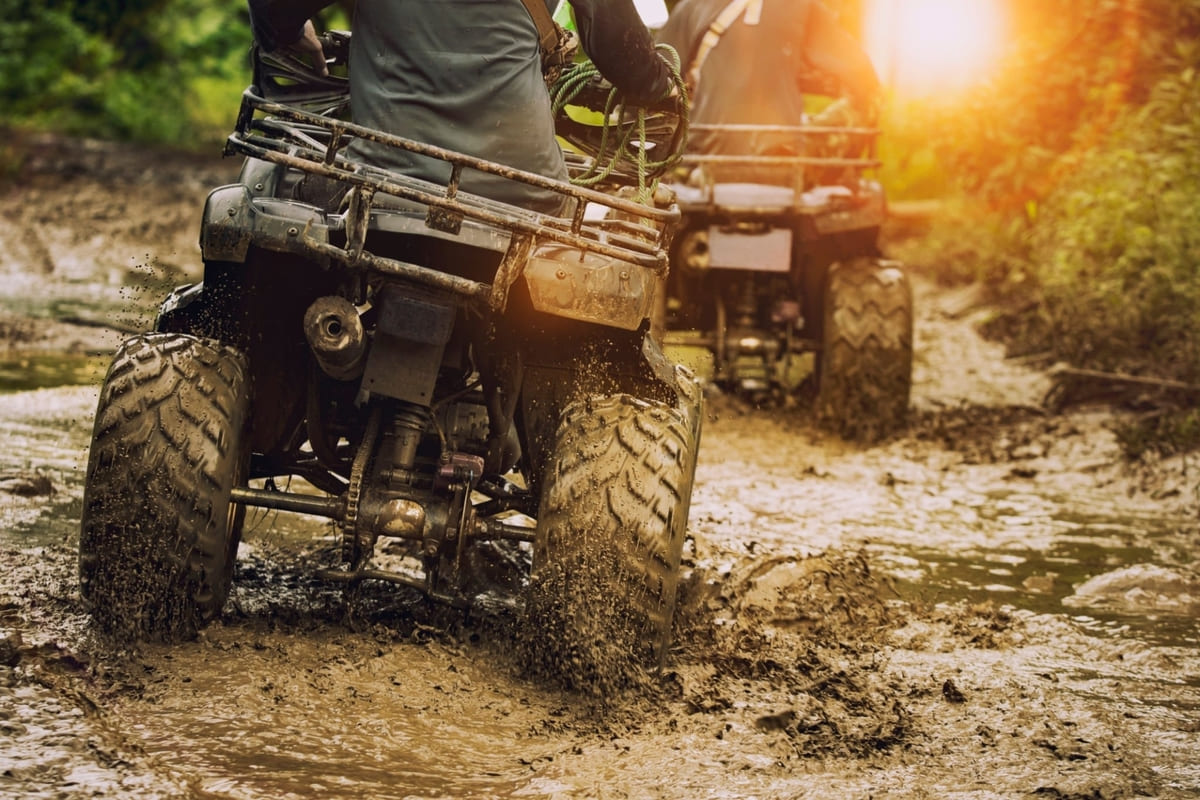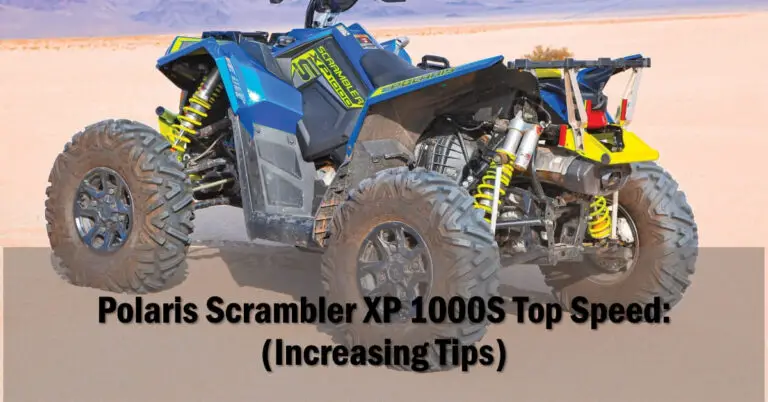ATVs Mastery Guide

All-terrain vehicles, also known as ATVs or quad bikes, are small, open motor vehicles with three or four large, low-pressure tires designed for off-road use on a variety of terrains like mud, gravel, sand, snow, etc. ATVs are very popular for recreational and utility purposes and this detailed guide will provide you with everything you need to know about ATVs.
Table of Contents
Types of ATVs
There are several types of ATVs designed for different purposes:
Sport ATVs
These lightweight, high-performance ATVs are built for one rider and used for recreational riding on trails and uneven terrains. They have powerful engines (250-1000 cc), short wheelbases for agility, sporty suspensions, and come in 2-wheel or 4-wheel drive options. Popular models are Honda TRX, Yamaha Raptor, Can-Am DS series.
Utility ATVs
Also known as work ATVs, they are designed for hauling small loads or pulling trailers. They have bigger cargo beds/racks, higher towing capacities and come in 2WD or 4WD variants. Some models like the Honda Rancher or Kawasaki Mule have selectable 2WD/4WD modes.
Youth ATVs
These are designed for young or novice riders above age 6 with easier handling, lower seat heights, less power (usually 70-125 cc engines) and safety features like speed limiters. Popular models are Honda TRX90X, Polaris Outlaw or Yamaha Raptor 50.
Sport-Utility ATVs
As the name suggests, they combine attributes of both sport and utility ATVs for recreational riding as well as moderate jobs. With mid-sized engines (400-700cc), they have some cargo capacity while being lighter and more agile than utility ATVs. Example models are Can-Am Renegade, Honda FourTrax Rancher AT.
Side-by-Side ATVs
Also called UTVs (utility task vehicles), they have side-by-side seating for driver and 1-3 passengers. They offer greater cargo/passenger capacity and comfort but reduced agility and ride quality compared to regular ATVs. They come in 2WD/4WD options with powerful 700-1000cc engines. Popular UTV models are Polaris Ranger, Can-Am Defender, Honda Pioneer.
Parts of an ATV
While ATV designs vary, most share some common components:
Engine
Modern ATVs have small but powerful single or twin-cylinder internal combustion engines ranging from 50-1000 cc. Most are 4-stroke gasoline engines with fuel injection, air- or liquid-cooling and electric starters.
Transmission
This sends power from the engine to the wheels. Manual transmissions with 5-6 gears are most common on ATVs. Higher-end models have automatic (CVT) or dual-clutch transmissions for easier operation.
Drive System
Most ATVs have rear-wheel drive but 4WD (selectable on some models) offers better traction. Drive shafts or chains transmit power to the axles. Differentials allow wheels to spin at different speeds for smooth turns.
Suspension
ATVs have double A-arm suspensions with shock absorbers on front and back. Independent suspension allows each wheel to move freely for a smooth ride over uneven terrain. Some models have adjustable shocks for different ride stiffness.
Brakes
Hydraulic disc brakes provide strong stopping power. Front and rear brake levers activate brakes on respective wheels. Some large ATVs have a foot-operated rear brake pedal as well.
Tires
ATV tires have thick, widely-spaced knobby treads for maximum traction on different terrains. Low-pressure, balloon-style tires conform to surfaces for a smoother ride. Tire material and tread patterns vary for use in mud, sand, snow etc.
Controls
ATVs have handlebar levers for brakes, accelerator on right grip, gearshift/parking brake and sometimes tools like headlights/2WD-4WD selector switches. Footpegs support rider’s feet. Larger UTV-type models have automotive-style controls.
Body/Frame
Made of steel/aluminum tubing or plastic panels mounted on a steel frame. Includes flat loading deck on utility models and seat for rider/passengers. Sport models have slim, lightweight frames and bodywork.
Safety Gear for ATV Riding
ATV riding poses many risks like collisions, rollovers, ejections etc. Proper safety gear is must:
- Helmet –DOT-approved helmet protects your head. Should fit comfortably and securely with chin strap tightened. Full face helmets offer most protection.
- Goggles – Essential to protect eyes from dust, debris, branches. Pick well-ventilated goggles that don’t fog up. Should fit outside helmet with secure head strap.
- Boots – Get boots specifically made for ATV riding with ankle support, hardened toe caps, deep tread soles and heel guards. Ensure a snug fit.
- Gloves – Should be well-fitting with knuckle protection and reinforced palms to absorb vibrations. Full-finger gloves preferred.
- Jacket/Jersey – Special ATV jerseys are made of tough fabrics like Cordura with padding on shoulders, elbows and back for protection.
- Pants – Made of durable synthetic fabric and have knee guards and hip padding. Baggy pants can get caught in moving parts.
- Neck brace – Helps prevent neck injuries in case of an accident. Important for kids and inexperienced riders.
- Knee/Elbow pads – For additional protection when riding over rough terrain. Straps should keep them from sliding off.
ATV Safety Tips
While ATVs are designed for off-road use, they can be unsafe in untrained hands. Follow these tips to ride safely:
- Take a hands-on training class if new to ATVs. Learn controls, riding techniques, safety practices before riding solo.
- Wear a helmet and protective gear every time you ride, regardless of distance. Gear up kids too. Replace worn gear immediately.
- Carefully read owner’s manual and warning labels before operating. Follow all age recommendations, safety guidelines.
- Perform pre-ride inspection. Check tires, fluids, lights, brakes and other parts. Ensure everything is in good working order.
- Do not overload your ATV’s capacity for cargo or passengers. Going over the limits can impact stability.
- Ride only in permitted designated areas. Avoid paved roads and highways except when crossing.
- Ride sober. Alcohol and drugs severely impair judgement and reaction time leading to accidents.
- Maintain safe speed suitable for terrain, visibility conditions and your skill level. Slow down for rough/slippery surfaces.
- Lean into turns and shifts in body weight to avoid rollovers. Move slowly and avoid abrupt maneuvers.
- Practise extra caution in bad weather, at night or when riding in unfamiliar areas.
- Watch carefully for obstacles like rocks, logs, ditches, fences hidden by vegetation. Learn to navigate safely.
- Avoid stunts unless you are a skilled, experienced rider. Tricks like jumps or wheelies can go dangerously wrong.
Choosing the Right ATV
With many types and models available, consider these factors when choosing an ATV:
- Intended use – Pick an ATV designed for how you plan to ride – recreation, utility, sports etc. This affects features needed.
- Engine size – Engine power is measured in cc. 50-125cc models are for kids. Over 600cc ATVs can be challenging for beginners. Select based on skill level.
- Manual/Automatic – Ease of driving manual vs convenience of automatic CVT transmission. Beginners may find auto easier.
- 2WD/4WD – 2WD saves weight and cost for simple riding. 4WD provides more challenging riding and traction in mud, hills.
- Rider size/age range – Check manufacturer specs on minimum rider age, height, weight capacity to suit yourself/family.
- Safety features – Look for speed limiters, long seat length, training wheels etc. on youth models.
- Cost – ATV prices range from under $3000 for basic models to $15,000 for high-end race ATVs. Set a reasonable budget.
- Brand reliability – Research issues, recalls, durability etc. for major brands like Honda, Yamaha, Polaris, Can-Am, Kawasaki.
- Test ride – Try out ATVs to gauge comfort, handling and power. Take turns, brake, lean on models you’re considering before deciding.
ATV Maintenance Tips
Proper maintenance is key to keeping your ATV in top working order. Some important tips:
- Change engine oil and filter as per owner’s manual, around every 20-40 hours of use. Check levels regularly.
- Inspect, clean or replace spark plug as needed. Check plug condition to detect issues.
- Check/adjust tire pressure before every ride. Inspect tread for damage. Uneven wear indicates alignment issues.
- Lubricate drive chain, control cables and other moving parts as per manual. Check for loose parts.
- Inspect brake pads regularly. Replace if excessively worn. Flush brake fluid every 2 years or as scheduled.
- Wash ATV after muddy/dusty rides to prevent damage from dirt, sand ingestion into moving parts.
- Check battery terminals, charge if required. Storing in cold weather reduces battery life.
- Replace air filter when visibly dirty. Use fuel stabilizer if storing ATV for months.
- Periodically inspect suspension, steering, chassis etc. for cracks, leaks or damage. Replace any worn parts.
- Adjust valve clearance, inspect carburetor, fuel lines, filters as per manual schedule.
Where to Ride your ATV?
While ATVs are designed for off-road use, rules vary on where you can legally ride them:
Private land
Get owner’s permission before riding on private property like farms, woodlands, ranch land.
ATV parks
These family-friendly parks have trails for different skill levels and vehicle types.
State parks/forests
Some have designated ATV trails but regulations differ. Get trail permits if required.
Public roads
ATVs are generally not street-legal. Transport unregistered ATVs on truck/trailer except for road crossings.
Paved roads
Riding on pavements is unsafe. Drive slowly in a straight line if you must cross roads. Avoid highways.
Environmentally sensitive areas
Stay off protected lands like wetlands, preservations, animal habitats etc. to prevent damage.
Getting involved in a local ATV riding club is a great way to find legal riding areas in your region while meeting fellow enthusiasts. Always be responsible and avoid trespassing private property or breaking local laws.
Common ATV Problems and Solutions
Despite routine maintenance, ATVs can develop issues. Here are some common problems and potential solutions:
Engine won’t start
Check battery, spark plug, fuel level/quality, starter motor. Clean carburetor jets, fuel filter/lines if blocked.
Loss of power
Examine air filter, spark plug, carburetor for blockages. Check fuel quality. May indicate engine problem.
Excessive vibration
Have wheels/tires checked for damage, balance. Check engine mounts. Loose components also cause shaking.
Steering pulls to one side
Inspect tire pressure and wear for imbalance. Align wheels if needed. Check steering components.
Brakes feel spongy/weak
Check brake fluid level and pads for wear. Bleed brakes to remove trapped air if needed.
Noisy chain
Clean and lubricate chain. Adjust chain tension. Replace excessively worn sprockets/chains.
Leaking fluids
Identify source of leaks – engine oil, brake/hydraulic fluid, fuel line etc. Seal, replace damaged gaskets, hoses.
If issues persist after checking basics, have your ATV serviced by an experienced mechanic to identify and resolve the problem. Avoid makeshift fixes as they could worsen issues.
ATVs can provide endless hours of off-road excitement but they also come with significant hazards if not ridden properly. Follow the safety practices, gear recommendations and riding tips outlined in this guide to ensure an enjoyable experience while staying safe on your ATV adventures. With responsible use and proactive maintenance, your ATV will deliver miles of trouble-free riding.







